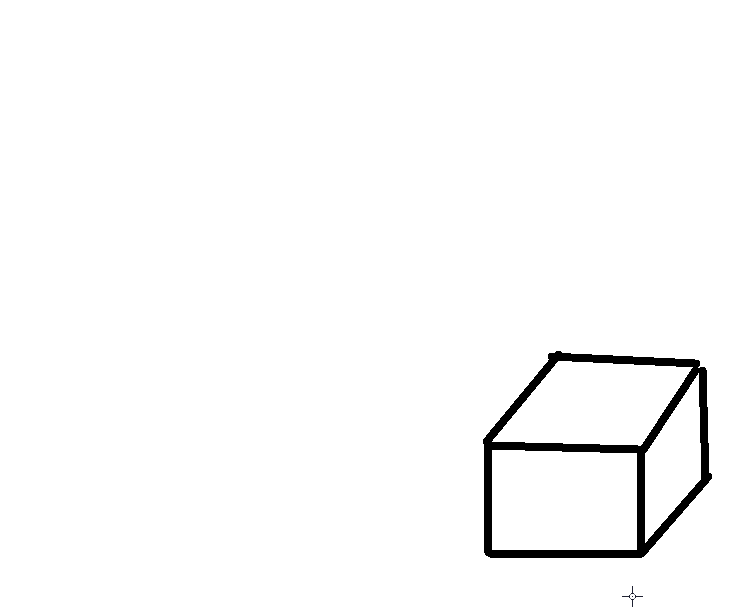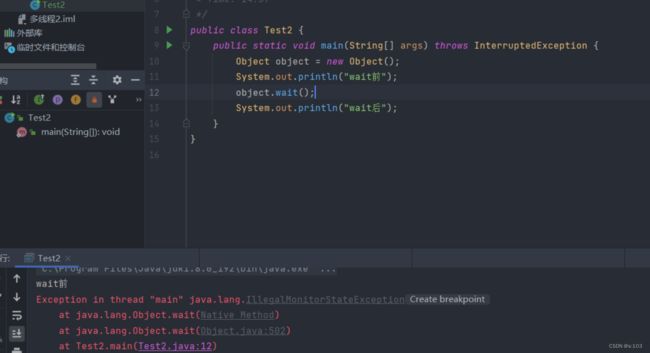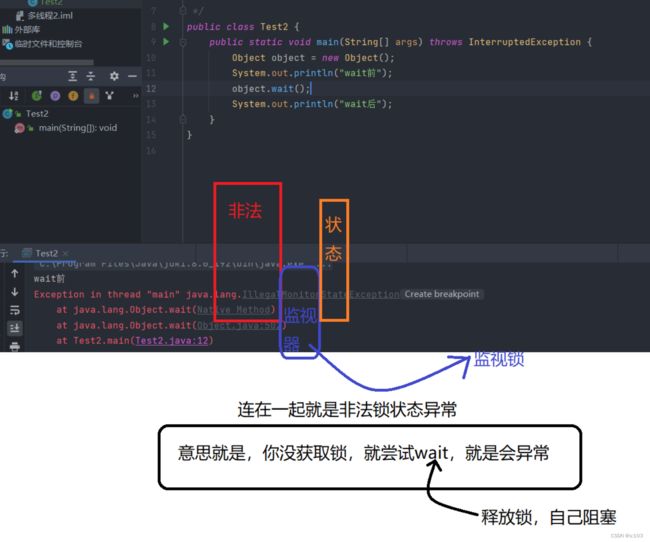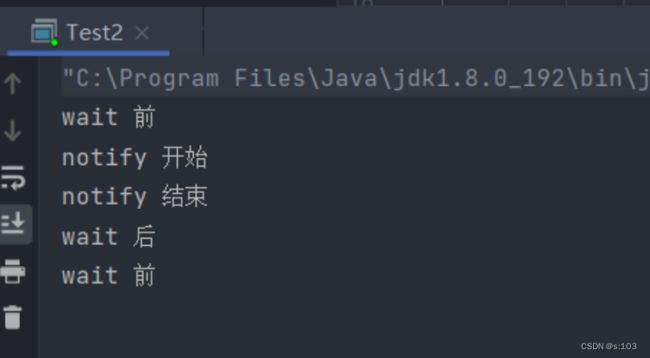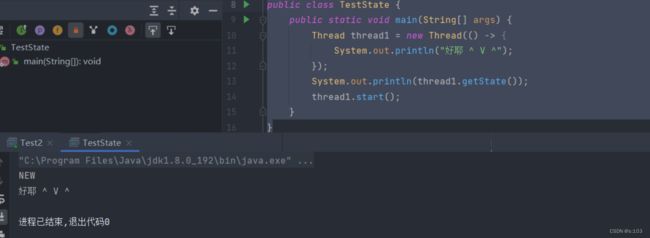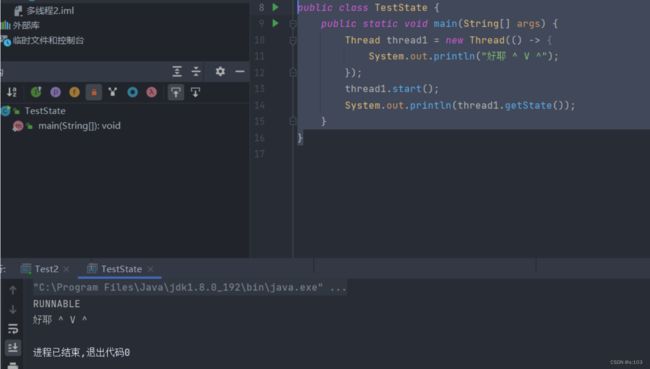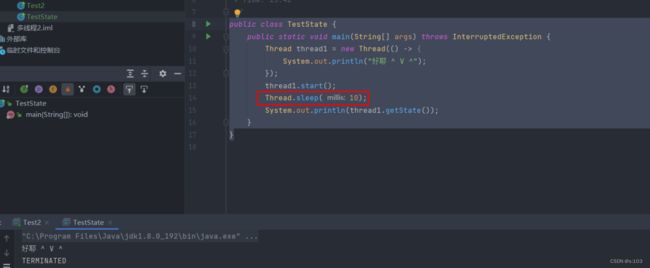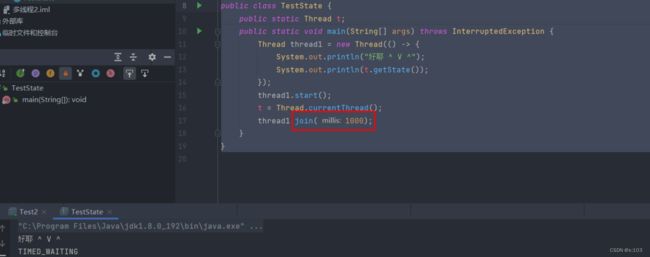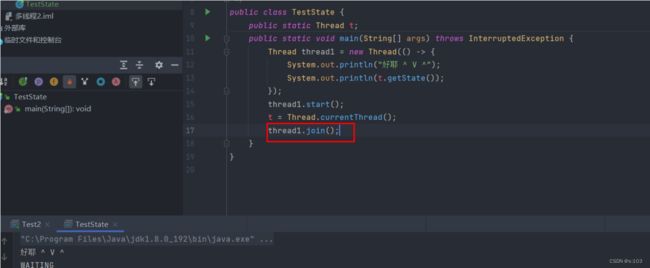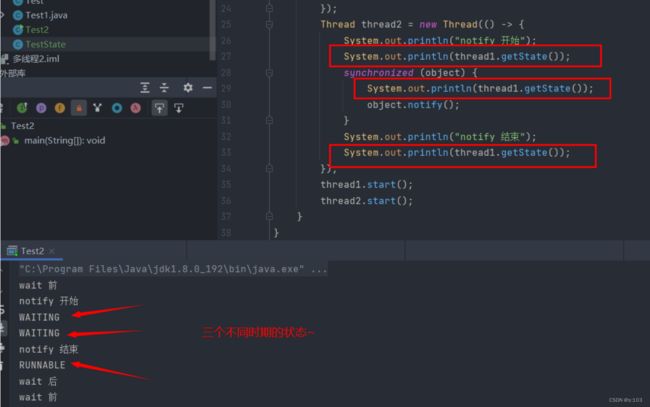JavaEE & wait and notify & 线程状态总结
哎呀,被我抓到了吧!
那你就别走了~
文章目录
- JavaEE & wait and notify & 线程状态总结
- 1. wait and notify
- 1.1 应用场景
- 1.2 wait与notify配合解决问题
- 1.2.1 wait和notify的使用
- 1.2.2 wait和notify代码规范
- 1.2.3 补充
- 2. 线程状态总结
- 2.1 NEW
- 2.2 RUNNABLE
- 2.3 TERMINATED
- 2.4 TIMED_WAITING
- 2.5 BLOCKED
- 2.6 WAITING
JavaEE & wait and notify & 线程状态总结
1. wait and notify
- 学到现在,我们已经了解到了阻塞的很多状况
- 阻塞的本质就是,纠正线程无序调度,让线程在某些需求场景下,有序进行
- join,等待整个线程结束/等待一段时间
- sleep,线程固定睡眠
- synchronized,等待锁
- 上面的三种,各有各的好,功效有限
- 阻塞的本质就是,纠正线程无序调度,让线程在某些需求场景下,有序进行
- 而wait呢,它也有它的特性
- 它引起的阻塞等待,就相当于给线程按了暂停键
- 而notify呢,则是让线程继续执行
- 而这个notify应该是阻塞线程外的一个线程调用的
- 什么时机按下启动键,看具体需要~
- 而这两个方法进行配合,可以更精细的控制线程调度顺序~
根据 【适用场景:::我们的初心】 去选择阻塞方式~
1.1 应用场景
- 假设你今天要去银行取钱,ATM没钱了
- 而其他人都有钱
- 假设那么ATM是个锁对象
- 那么你跟其他人一起抢这个锁去操作
- 而你是要取钱的,如果没人存钱或者没有工作人员运钞填入钱,你就不能取到钱
- 尽管你抢到锁也没用~
- 那么,如果你在一个很短的时间内,反复抢到锁,那么是不是就是在浪费时间
- 这个时间很短,线程的记账信息还没起作用~
- 而接下来,我们就是为了解决这个问题~
1.2 wait与notify配合解决问题
- 基本思想就是
- 你抢到ATM机了,你取不到钱,你就wait,直到别人来notify你说,你可以去取钱了~
1.2.1 wait和notify的使用
- wait和notify都是Object类的方法,只要不是基本数据类型的变量,都可以调用~
- 谁调用wait,则对应该线程就会阻塞等待
- 谁调用notify,无所谓,随机唤醒一个WAITING的线程
- 简简单单的调用是会报错的~
- 这里也体现了wait的主要要做的三件事:
- 释放锁
- 阻塞等待
- 等待通知唤醒,唤醒后继续参与“抢锁”
- 补充: notify能够唤醒的线程,必须和notify的锁对象是一样的
- notify要依据这个锁去唤醒线程~
- 没有抢到锁,就notify一样会报错
- 并且notify也有一步操作是,释放锁,否则被唤醒的线程和其他线程无法去抢夺锁
1.2.2 wait和notify代码规范
- 必须先wait再notify才有效果,否则就没有效果
- 将相当于你取得到钱,你也没wait阻塞等待,就有人来notify你说,可以取钱去了,你会觉得莫名其妙,但是对你没有什么影响
public class Test {
public static void main(String[] args) throws InterruptedException {
Object object = new Object();
Thread thread1 = new Thread(() -> {
while(true) {
System.out.println("wait 前");
synchronized (object) {
try {
object.wait();
} catch (InterruptedException e) {
e.printStackTrace();
}
}
System.out.println("wait 后");
}
});
Thread thread2 = new Thread(() -> {
System.out.println("notify 开始");
synchronized (object) {
object.notify();
}
System.out.println("notify 结束");
});
thread1.start();
thread2.start();
}
}
- 测试结果:
- 顺序正常~
- 这就是通过具体情况,调整cpu调度顺序的方式~
很多方法都能引起这种效果,但是初心不同,所以,要看具体想法,使用特定的方式~
1.2.3 补充
- wait还有一个重载方法,提供了带参数的方法
- 这个参数代表了,最长等待时间,超过该时间,就自动唤醒~
- notify还有一个哥哥,notifyAll
- 他可以根据自己的锁对象,去唤醒所有对应的线程~
- 而notify是随机唤醒多个中的一个~
-
sleep,join好像也能被中断唤醒,也有时间限制,这样就跟wait差不多了咯~
- 没错,这个场景差不多,但是他们的初心不一样
- 在不同场景用更加有针对性的方式,才是好决策~
-
目前的场景只是为了体现wait和notify的使用方式
-
你可能没能体会到,他们的配合的在这里对任务的针对性~
- 并且,锁代码块也并不是只有那么个语句~
- 以后写的应该是特定情况下会wait~
- 并且,锁代码块也并不是只有那么个语句~
-
没有关系,后面我会写几篇博客,研究 Java多线程的一些案例
-
- 综合线程知识去研究
- 结合具体场景运用不同方式
-
2. 线程状态总结
- 在之前的《进程与线程》博客里给出这张图,由于部分知识未学习,现在重新看一遍~
- 接下来,我将讲解各个状态,并且用代码去测试
2.1 NEW
NEW 线程还没被创建出来,只是存在这个线程对象~
- start 创建 + 启动
- 也就是说start之前~
public class TestState {
public static void main(String[] args) {
Thread thread1 = new Thread(() -> {
System.out.println("好耶 ^ V ^");
});
System.out.println(thread1.getState());
thread1.start();
}
}
2.2 RUNNABLE
RUNNABLE 运行/就绪状态
- 正在CPU上运行准备好
- 随时可以去CPU运行
- 这两种情况,基本“同时”
- 因为线程并发执行的原因
- 所以一个线程总是处于运行和就绪的状态~
- 但是这一个很小的时间内,并不是阻塞~
public class TestState {
public static void main(String[] args) {
Thread thread1 = new Thread(() -> {
System.out.println("好耶 ^ V ^");
});
thread1.start();
System.out.println(thread1.getState());
}
}
2.3 TERMINATED
TERMINATED 系统中的线程已经执行完毕~
- 但是线程引用还在~
- 通过这个“还在的”引用去查看状态
由于线程调度的随机性,所以2.2代码是可能出现TERMINATED状态的,如下图:
- 但是概率低~
所以我让main线程等一会儿~
public class TestState {
public static void main(String[] args) throws InterruptedException {
Thread thread1 = new Thread(() -> {
System.out.println("好耶 ^ V ^");
});
thread1.start();
Thread.sleep(10);
System.out.println(thread1.getState());
}
}
2.4 TIMED_WAITING
TIMED_WAITING
- 被指定时间的等待—sleep
- 对于join方法
- 即使正在等待的线程是完全阻塞的状态
- 我们可以通过全局性质的静态变量去获得线程引用并在lambda表达式中被捕获到~
- 如果有时间限制就是TIMED_WAITING~
- 否则是WAITING~
public class TestState {
public static Thread t;
public static void main(String[] args) throws InterruptedException {
Thread thread1 = new Thread(() -> {
System.out.println("好耶 ^ V ^");
System.out.println(t.getState());
});
thread1.start();
t = Thread.currentThread();
thread1.join(1000);
}
}
public class TestState {
public static Thread t;
public static void main(String[] args) throws InterruptedException {
Thread thread1 = new Thread(() -> {
System.out.println("好耶 ^ V ^");
System.out.println(t.getState());
});
thread1.start();
t = Thread.currentThread();
Thread.sleep(1000);
}
}
public class TestState {
public static Thread t;
public static void main(String[] args) throws InterruptedException {
Thread thread1 = new Thread(() -> {
System.out.println("好耶 ^ V ^");
System.out.println(t.getState());
});
thread1.start();
t = Thread.currentThread();
thread1.join();
}
}
2.5 BLOCKED
BLOCKED
- 表示等待锁出现的状态
class Counter {
private int count = 0;
public void add() {
synchronized (Counter.class) {
count++;
}
}
public int get() {
return count;
}
}
public class TestState {
public static Thread t;
public static void main(String[] args) throws InterruptedException {
Counter counter = new Counter();
Thread thread1 = new Thread(() -> {
for (int i = 0; i < 5000; i++) {
synchronized (counter) {
counter.add();
System.out.println(t.getState());
}
}
});
thread1.start();
t = Thread.currentThread();
for (int i = 0; i < 5000; i++) {
synchronized (counter) {
counter.add();
}
}
}
}
- 而main线程可能很快就会执行完,所以就没必要阻塞等待了~
2.6 WAITING
- 主要是因为wait方法
- join()不带参数版本,是等待整个线程结束
- 很直接
- join()不带参数版本,是等待整个线程结束
- 下面在线程2notify前后分别去查看线程1的状态~
public class TestState {
public static void main(String[] args) throws InterruptedException {
Object object = new Object();
Thread thread1 = new Thread(() -> {
while(true) {
System.out.println("wait 前");
synchronized (object) {
try {
object.wait();
} catch (InterruptedException e) {
e.printStackTrace();
}
}
System.out.println("wait 后");
}
});
Thread thread2 = new Thread(() -> {
System.out.println("notify 开始");
System.out.println(thread1.getState());
synchronized (object) {
System.out.println(thread1.getState());
object.notify();
}
System.out.println("notify 结束");
System.out.println(thread1.getState());
});
thread1.start();
thread2.start();
}
}
文章到此结束!谢谢观看 !
可以叫我 小马,我可能写的不好或者有错误,但是一起加油鸭!后续会有几篇关联博客,单例模式,阻塞队列,工厂模式,计时器,线程池等等…
敬请期待吧~
